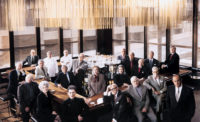Editor's Note: This story is from the July 1958 issue of Architectural Record. See the original pages here, and read our Record Looks Back essay, “Goodbye to All That," from the July 2016 here.
Big, splendid and very expensive (mere art lovers may buy a drink at the bar), the new restaurant in the Seagram building is called The Four Seasons. More than a name, it is the restaurant's idea. Four trees, pink for spring, green for summer, red for fall and brown for winter form the constant graphic motif, but each color establishes the palette for its own season. Each of the four colors appears in its turn on waiters' jackets, menus and matchbooks, while other changing colors, those of flowers for example, harmonize with it.
The restaurant's decor changes in accord with another briefer time sequence. The sculptures over the bar and mezzanine, made of thousands of gold dipped brass rods by Richard Lippold, quiver almost imperceptibly in the light, creating gently changing patterns. According to Philip Johnson this movement is caused by the "shock of New York"; specifically perhaps by the trains roaring under Park Avenue toward Grand Central. The window draperies also move. Made in the style of Vienna curtains in three tones of gold anodized aluminum chain, they present a constantly rippling appearance as each chain swings forward and back within an infinitesimal arc in a movement caused by air convection at the window. The rippling is also seasonal as it relates to contrasts between inside and outside air temperature. Movement was greater in summer than fall, will increase in the winter and subside in the spring.
Owner: Restaurant Associates, Inc.
Architect: Philip Johnson Interior
Design: William Pahlmann Associates
Landscape Architect: Karl Linn
Lighting Consultant:Richard Kelly
Graphic Artist: Emil Antonucci













Post a comment to this article
Report Abusive Comment